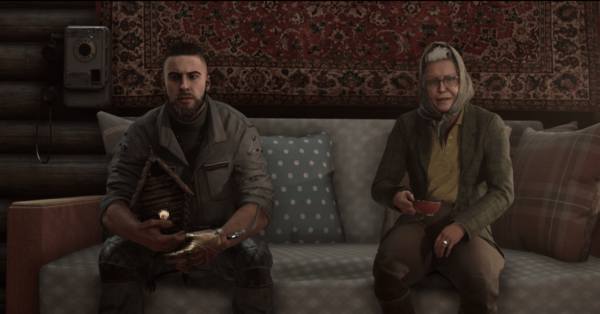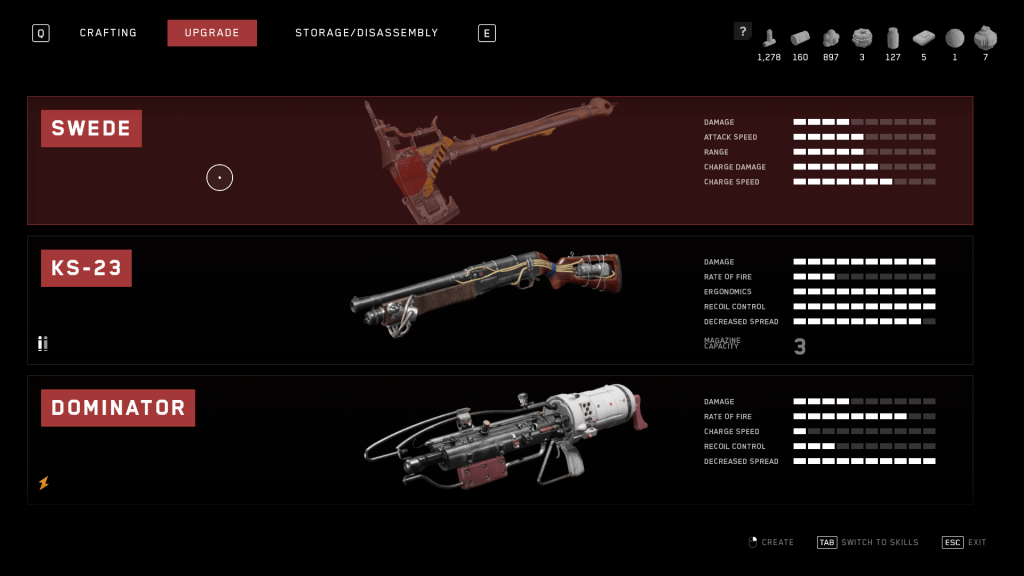Atomic Heart Review | Caution: Rogue Robots
Atomic Heart is by no means perfect as it does have its fair share of issues, but its unique elements make for an enjoyable time.

There’s been quite the amount of hype surrounding Atomic Heart, and for a number of reasons. One of which, was the sheer amount of hype that it generated after its very first trailer reveal almost half a decade ago. It featured colorful aesthetics, smooth shooting mechanics, and in-your-face horror.
After getting a taste of some gameplay ourselves and having a conversation with the gamer’s creator himself, it’s safe to say I was looking forward to getting my hands on the game itself. After about 15 hours or so, I’ve gotten the Atomic Heart experience, and gathered my thought–shaken as they were.
So, did the game live up to everyone’s expectations or is it just another run-of-the-mill FPS that tries to hard? Let’s get right into it.
A colorful killzone
Let’s talk about how the game looks. You’re thrown right into post-war victorious Soviet Russia, and you can tell. The fanfare, the vivid colors, and the bombastic music set the tone as you go through the semi-explorable “tutorial” stage. The first area is brimming with life, and while you can tell its scripted, the attention to detail helps with the suspension of disbelief. It’s a loud and lively utopian city that makes things all the more sad as you know that this is, at the end of the day, a horror shooter.
Most of the beginning is shown in the teaser trailers, so I’m not spoiling anything here. However, I will tread carefully by saying that everything that follows is one roller coaster both for the eyes and mind. You’ll go through some very detailed, yet captivating areas that show the horrors that one would expect from a nation that toys with science and warfare.
Mick Gordon and everyone who contributed their musical talent to this game should be applauded. From classical pieces, to techno synth, to gritty hard rock–each track worked really well with the game, and boosted the tension and excitement during my playthrough. Sound design was also on point, from the cathartic feeling of gathering items to the loud pops from your shotgun–it was all satisfying.
It’s both pleasant and at times, tense to traverse the different areas, gathering loot, killing both organic and robotic enemies, and unraveling more of the game’s plot. While the game is, in essence, linear, it does its best to give players more space to explore and approach their playthroughs differently. For example, I never drove a car. Still fun.
I do wish there was fast travel, and an easily accessible map that didn’t require you to go outside just to view. It can get hard to backtrack if you miss anything–and if you don’t like to explore, believe me, you’ll miss a lot of important crafting materials and blueprints. For context, I just did a linear playthrough. I finished with the starting weapons, three that you get from the story, and two consumables from easy-to-find recipes. And mind you, those weapons weren’t fully upgraded because I didn’t find the blueprints for the accessories.
That being said, I did manage to finish the game, and the starter weapons are powerful enough. We can say that the game doesn’t necessarily punish you for not exploring, it just doesn’t reward you with, like, an AK.
In Soviet Russia, robot dismantles you.
Now, let’s talk about the enemies. While challenging, menacing, at towards the end, annoying as they are–the variety is quite limited. You have your creepy mustached robot, creepy mustached robot in a BDSM suit, flying robots, thicc robots, rolling robots, zombies, and bigger zombies. Of course, I exaggerate as there are more, but you’ll be seeing a bit of the same for the most part. This isn’t all bad, though. At the very least, you’ll be able to know what you’re up against, and you can deal with them accordingly. In higher difficulties, you’ll need to take note of this.
The bosses are a different story. Each one, upon introduction, is over the top. Of course, you start small with a mutated version of the usual zombie–and then conclude the game with a Dark Souls final boss. I’m not even kidding.
They all have their attack patterns, strengths, and weaknesses which you’ll have to find out yourself. You’ll find satisfaction in downing a huge robot with a fire axe, incinerating a terrifying plant-human hybrid, and surviving an earth-shattering shockwave with just a bit of HP to spare. They’re spectacular to watch, and a lot of fun to fight.
Comrade’s cache of hurtmakers
While it employs a multitude of different elements and aesthetics, Atomic Heart is a horror shooter. In this aspect, it performs well. You get a variety of character improvements and buffs that help you build up your ideal “P-3.” You can run, shoot, dodge, and jump quite smoothly, and you’re guaranteed to get kick out of it. The UI is tidy and rather simple. This makes things more efficient in handling your inventory.
I also appreciate the weapon and power mechanics the game employs. You get a beefy crafting system that allows you to create both weapons and resources from the materials you gather. The weapons and powers are easy enough to upgrade, satisfying to use, and suit a variety of player preference. While the melee weapons could be a bit more satisfying, I had fun making it my main build.
One thing I truly enjoyed was the telekinetic power built into your sentient glove, Charles. While it’s a bit of a wet noodle in combat when not upgraded, the sheer satisfaction of sucking out all the loot from boxes, chests, and the guts of your enemies is something worth talking about. This, alongside your other “magic hand” powers add more potential in combat than the usual.
Also, the a few of the powers could’ve used a bit more tweaking as a couple are totally overpowered, while others aren’t even worth using. If you like to min-max your build, you won’t have any trouble. If you like to experiment, you might be left a bit uninterested.
The misadventures of P-3 and his glove
Our main characters, while serviceable, strong and have a bit of depth in terms of motivation–talk a bit too much. Now, while the banter doesn’t get too annoying throughout the game, there’s a bit too much dialogue that overlaps during key moments–moments which could’ve been better with verbal reactions or complete silence. There are also moments when conversation go straight into combat encounters, which can be disjointed from what’s happening on-screen.
I switched to Russian voice acting with English subtitles for a more natural feel. The English voice acting wasn’t really doing it for me. The quips P-3 would throw around weren’t really my cup of tea, and while it wasn’t bad, it just took away from the overall tone of the game.
The supporting cast are decent, and the villains can be either calm and collected or hilariously over the top. I quite enjoyed interacting with them. They weave into the game’s plot rather well, and don’t really seem out of place, given the premise. The story itself is a bit intriguing on its own, and has a nice little twist towards the end that also depends on decisions you make in the game.
In terms of missions, some are straightforward and easy–while others are straightforward and dragging. You’ll encounter a few multi-sectional quests that almost always involve collecting several key items across a sprawling area. This was great the first time as it expanded on the lore, but it can get rather tiresome as it seems like padding for time later on. The environment helps makes things less dreary, though.
In terms of the story, there’s a bit to unpack–and I don’t want to spoil anything. Let’s just say that it’s simple enough to follow, has a few twists here and there, and makes really good use of the game’s aesthetics.
Yes, that was actually in the game.
Paying homage to the classics
Now that we’ve gotten all of the basics out of the way, let’s talk about what Atomic Heart does a bit different compared to its modern contemporaries. Aside from a bit of platforming, you’ll run into a ton of puzzles. If you got a feeling of Bioshock and Dishonored early on, then Portal and Half-life will start making sense once the game really gets going.
You’ll run into challenges that’ll leave you stumped for a few minutes–to half an hour. If you’re quite the smarty pants, logical-thinking gamer, then they’ll be a breeze. A bit of hand-eye coordination helps a bit as well. However, if you’re a dumb scrub like myself, then you better find something else to do while recharging your brain, because some puzzles that forward the plot can be mind-boggling for those who aren’t accustomed to this kind of gameplay mechanic. This is good, as it offers variety in playing, and give you a bit of breathing room between getting murdered by…everything.
That being said, the minor puzzles can get repetitive, and if you’ve been playing straight for hours, quite tedious. While they ramp up in difficulty, they don’t vary. Instead of 6 power grids, you get 8. Instead of one puzzle lock, you get two. All of which are peppered into each area one after the other. A bit of variety would’ve been nice.
All-in-all, this was a good step in standing out from the crowd, and something that both Mundfish and other studios can expand upon in future titles. It is nice that Atomic Heart brought it to center stage.
Final Verdict: 8/10
Atomic Heart is by no means perfect, but a damn good first title. Stepping away from the usual FPS expectations to tell a story and elicit emotions was a good move, and while some gameplay elements didn’t hit the bullseye, they laid the groundwork for any game developers who’d like to spice things up by deviating from a certain genre’s course. The horror shooter with puzzles isn’t exactly new, but Atomic Heart applied the formula differently, and it turned out rather enjoyable.
All my gripes aside, I did have fun playing–and this is someone who isn’t exactly into shooters in general. It’s hard, but satisfying. Yes, I know how that sounds.

Any technical problems could be chalked up to my rig, which garners a few more points for the game as it looks pretty good at medium settings on a GTX 1650. As of now, we’re looking at a few DLCs coming up within the year, so that could be something to look out for.
If you want to experience the rollercoaster of gore and emotion yourself, then follow your Atomic Heart.
This review was made using a game code for PC provided by the publisher.


















